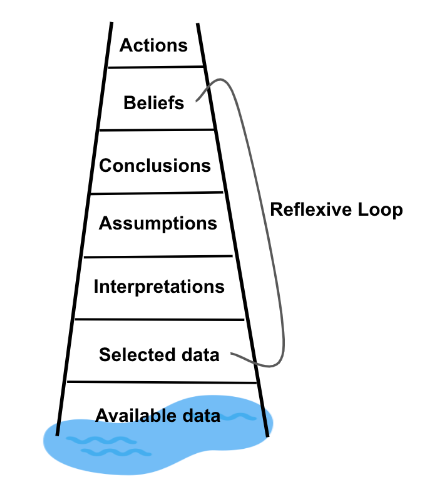Our actions and decision-making process are influenced by the situations we encounter, our understanding of them, and the conclusions we draw. Although our perceptions may seem evident to us, others may interpret situations differently based on their own perspectives. On a daily basis we interpret situations and jump to conclusions, making rash decisions that could be avoided with better reasoning.
The Ladder of Inference, a framework divided into distinct steps, serves as a valuable tool for analysing human reasoning – from comprehending situations to taking action.
Understanding the Ladder of Inference:
The Ladder of Inference comprises seven steps that mirror the human mental process:

Let’s analyse each step, starting from the bottom:
Available data
This is the observable data or reality, such as facts, data, experiences, people’s reactions, statistical results, reports, etc.
Selected data
Based on available data we have access to, a subconscious selection is made, often influenced by personal experiences and beliefs.
Interpretations
Meaning is applied to the selected data, and individuals interpret both what others say and how they behave differently, as well as quantitative data.
Assumptions
Derived from the interpretation, we create our own assumptions, highly influenced by our previous personal experiences.
Conclusions
We draw conclusions from our assumptions, attempting to explain facts through the constructions of causal theories that are built on our values.
Beliefs
Adopting beliefs based on drawing conclusions becomes the next step in the process.
Actions
As a final step, final decisions and actions are taken based on what we believe to be true.
This framework is often unconsciously followed in daily decision-making. However, applying it consciously enhances decision relevance. By stepping back and considering aspects not initially contemplated, rash conclusions can be avoided.
How can we use it?
To use the framework effectively, work down the ladder before reasoning up. Firstly, identify in which step you are and then work it down before reasoning up again.
There are some guiding questions for each of the step that should be taken into consideration:
Actions: Why is this the right action? Are there alternative options?
Beliefs: What beliefs do I have related to this? What conclusions are they built on?
Conclusions: Why did I reach this conclusion? What are my assumptions?
Assumptions: Why am I assuming this? Is the assumption valid?
Interpretations: Am I analysing the data objectively? Are there other meanings?
Selected data: Is there something that I ignored or did not pay attention to? Are there additional sources I should consider?
By answering these questions, the reasoning may change or one may find that some information is missing or incorrect. Then, once the bottom of the ladder is reached, you can work your way up again, in a more conscious way.
Limitations
In theory this looks like an easy approach and something that can be easily applied, right? However, this framework can create bad judgement through a reflexive loop.
The reflexive loop
Our assumptions, values and beliefs influence the selection of data in subsequent situations, reinforcing initial interpretations and decisions. This can be negative in the sense that it can prevail over the available data and situations, preventing us from seeing alternative ways of understanding and acting.
Example
| Ladder | Example |
| Actions | When John suggests to work with me, I will try to avoid it as I always meet a deadline and I am a serious professional, opposed to John |
| Beliefs | I decided I should not trust fully in this person’s work if he is not capable of meeting a deadline |
| Conclusions | He obviously think that deadlines do not apply to him and/or that he is more than others |
| Assumptions | John does not care about deadlines and delivers work late just because |
| Interpretations | He knew exactly when the deadline was and did not bother to deliver the work on time |
| Selected data | John did not apologised or explained why he was delivering his work later than the deadline |
| Available data | John had to deliver a report until Tuesday at 15h and only delivered it at 17 |
Based on John missing a deadline and me not having more information, I am forming my own interpretations, assumptions, and conclusions that are built on personal beliefs and values. However, even though John did not meet this deadline, it does not necessarily mean he is unprofessional or consistently fails to meet deadlines. Therefore, we need to pause and analyse each step of the ladder carefully to make room for other alternatives and avoid jumping to conclusions.
Conclusion
The Ladder of Inference serves as a valuable seven-step guide to decision-making:
-
- Observe data & experiences
- Select data from what you observe
- Add meaning to observations
- Make assumptions based on the meaning
- Draw conclusions from your assumptions
- Adopt beliefs about the world
- Take actions based on those beliefs
Step one is the bottom of the ladder. Always remember to start analysing from the bottom to the top, and once all underlying questions are answered, you can progress upward.
Do not jump up the ladder! Our own conclusions may seem obvious to us, but we should be critical about them. Going step by step can help with this. Additionally, people reach different conclusions and will always consider theirs as obvious, thinking that others are wrong.
By using this framework, we can search for alternatives, understanding different assumptions and conclusions, and thereby find solutions.
Remember to focus on details and collect objective data to improve the decision-making process and prevent bias or jumping to conclusions.
Sources:


